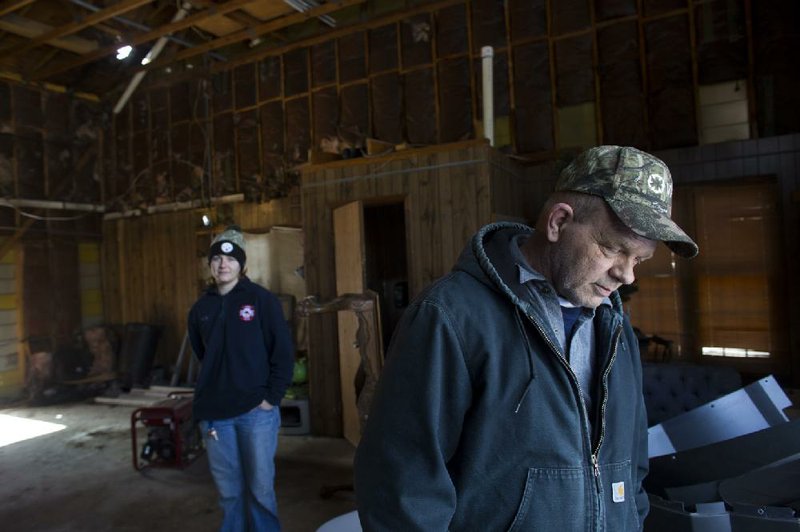Volunteer firefighters from the Quail Creek department returned frustrated to a house fire on a cold January night in southern Pulaski County.
They had left the scene a short time earlier, unaware flames still lurked beneath the home's floor. Chief Stephen Feyen said he is sure they would have extinguished the fire the first time with a piercing nozzle -- a $700 piece of equipment on the department's long wish list.
The Quail Creek department squeezes by on a $30,000 annual budget, making routine purchases difficult, if not impossible.
At Quail Creek's dilapidated fire station about 10 miles south of downtown Little Rock, Feyen said, "A piercing nozzle is a common piece of equipment, but we don't have it."
Times are changing for departments like Quail Creek -- would-be volunteers are leaving rural areas for cities, industry standards are tightening and technological advancements are leaving equipment outdated -- but funding shortfalls still pose the toughest challenge, state and area leaders agree.
Homeowners are seeing their insurance premiums skyrocket in districts where struggling departments have poor insurance ratings.
The better a rating is, the lower the insurance premiums homeowners in those fire districts pay, said Dawn Boston, vice president of the Florida-based Stillwater Insurance Group, which underwrites policies for Geico.
"We're in the business of insuring risks," she said. "When you look at a rural community with a volunteer fire department and a low class rating, you usually have two times the amount of fire losses. It's not because they have more fires. It's because when they do have a fire, there's a greater loss."
Insurance companies use class ratings produced by the New Jersey-based Insurance Services Office to determine a fire department's ability to mitigate fire damage. In Arkansas, the majority of fire departments have a rating of 9, the second-worst on a 10-class scale on which 1 is the best.
Class ratings usually reflect size and funding; larger, well-funded departments boast lower numbers.
The Insurance Services Office considers a variety of factors in a class rating, including manpower, equipment, emergency communications and water supply.
The Quail Creek department, which serves 8.8 square miles and 820 people, lacks more than piercing nozzles. Utility and fuel costs consume most of the department's $30,000, Feyen said. The department can't afford capital improvements.
Some state lawmakers hope to introduce measures during the 2017 legislative session to remedy problems faced by Quail Creek and similar departments. Feyen said he hopes that isn't too late.
The nine-man department has three trucks, but it might as well only have two. The third truck -- the newest, an early 1990s model -- won't start, and all three driver's-side tires are flat. It's housed in a building on the brink of collapse because a tree fell on it several years ago and there's no money to fix it.
The station doesn't have running water, so soot and debris accumulate on the volunteers' firefighting suits because they have no way to wash them.
B.J. Bradford, who has 40 years of experience in the fire service, became Quail Creek's assistant chief at the start of the year.
Bradford began contacting everyone who could possibly help -- friends in high places, media outlets and anyone else willing to listen. The department even created an online crowdfunding page to give people an easy way to help.
"I'm not going to let this department die," Bradford said.
Quail Creek is only one example of the hundreds of struggling departments in Arkansas. Of the 1,003 fire departments in the state, 903 are volunteer. Almost all of them need money, said Kendell Snyder, fire services coordinator for the Arkansas Department of Emergency Management.
Snyder oversees the distribution of insurance premium tax money collected by the state as a secondary source of money for fire departments. The funding mechanism was created by Act 833 of 1991.
Quail Creek receives about $5,770 each year from Act 833, according to the Department of Emergency Management. Pulaski County property taxes provide the remainder of its budget.
"It's a real burden on this little group of people who really are trying to take care of their communities," Snyder said of volunteer firefighters.
The Bay Fire Department, a volunteer outfit serving 46 square miles and 2,378 people in northeast Arkansas, receives a combined $35,000 each year from the state and the city of Bay. It's in better shape than many other volunteer departments -- a feat that 26-year veteran and former state Firefighters Association President Kevin McMasters attributes to years of dedication and hard work.
A $98,000 grant the department received a few years ago didn't hurt, either. The money replaced much of the firefighters' gear.
"Grants are critical for capital improvements," but a little bit of oil and elbow grease go a long way, McMasters said.
Bay isn't immune to funding shortfalls, though. The two-station department needs to replace its oldest station. It was built 60 years ago before modern firetrucks were designed, limiting the size of truck the department can house there because of the low ceiling.
Bradford had planned to apply for grants when he joined the Quail Creek department, but he found a backlog of about 1,000 uncompleted reports. The reports' completion is mandatory for any department filing for grant money at the state or federal level.
The department doesn't have a computer on which to file reports. The report backlog -- like many problems -- preceded any of Quail Creek's current volunteers.
In addition to applying for grants to boost their funding, many volunteer fire departments collect dues from residents in their districts.
Yearly dues range from $20 to $150, but Snyder said departments are lucky to collect dues from half the district residents. The fees are voluntary, and there's no consequence for failing to pay until a delinquent resident has a fire, he said. Then, fire departments may bill the resident for the costs of fighting the fire.
Crow Mountain Volunteer Fire Department, which serves 23 square miles and 5,029 people outside Russellville, recently increased its dues from $20 to $80. The added money improved the department tremendously, said state Sen. Greg Standridge, R-Russellville, a former Crow Mountain fire chief.
Crow Mountain was one of the first volunteer departments in the state to add its dues to residents' property tax bills. The fee is still voluntary, but the percentage the departments collect is exponentially higher when people see the dues on their tax bills, Standridge said.
Standridge is a co-chairman on the joint rural fire departments study committee in the state Legislature, a volunteer firefighter and an independent insurance agent.
"I know first-hand how these departments struggle," he said.
In 2015, legislation made it easier for volunteer departments to put their dues on property tax bills. Before Act 693 of 2015, a department would have to fund a ballot measure, but the new law accepts a petition signed by the majority of registered voters in a fire district.
Quail Creek doesn't collect dues. Feyen works full time at the Pulaski County Road Department. Bradford is a full-time school nurse. Neither knows the process for implementing dues, they said.
Standridge and Rep. James Ratliff, D-Imboden, are working on another piece of legislation to present in 2017. The plan would take surplus money collected under Act 833 and disburse it to departments with an Insurance Services Office rating of 9 or 10.
Standridge hasn't yet determined the best way to fund the plan, but the money would be available only to departments with dues collected on property tax bills.
Standridge said it's "do-able" for departments to improve their insurance ratings by two or three points with a few small changes.
"That makes a big difference," he said. "People may not like paying dues, but if you improve your class rating a few points, it can save your community 40 percent on homeowners insurance.
"If you pay $2,000 a year for homeowners insurance, that's almost $1,000 you're saving. I don't think people will mind paying $50 or $60 if that's the case."
Quail Creek volunteers are doing everything they can to improve their situation. They're wading through the backlog of reports and spending free time fixing what they can around the station.
"You can go a long way with grit and effort, but at some point, you're going to need some resources," McMasters said.
If the Quail Creek department were to close, only those living in its district would feel the effect at first. But eventually, the neighboring districts, forced to serve a larger area, would suffer.
"We're trying to do the most good we can," Bradford said. "We've done everything we can do, and I've spent all the money my wife will let me."
NW News on 01/25/2016

